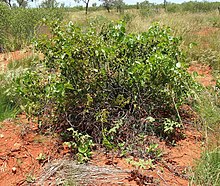
The sweet potato or sweetpotato is a dicotyledonous plant that belongs to the bindweed or morning glory family, Convolvulaceae. Its large, starchy, sweet-tasting tuberous roots are used as a root vegetable. The young shoots and leaves are sometimes eaten as greens. Cultivars of the sweet potato have been bred to bear tubers with flesh and skin of various colors. Sweet potato is only distantly related to the common potato, both being in the order Solanales. Although darker sweet potatoes are often referred to as "yams" in parts of North America, the species is not a true yam, which are monocots in the order Dioscoreales.
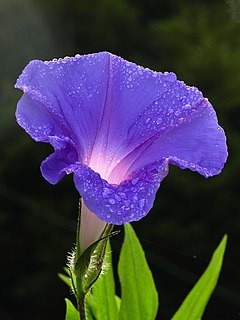
Morning glory is the common name for over 1,000 species of flowering plants in the family Convolvulaceae, whose current taxonomy and systematics are in flux. Morning glory species belong to many genera, some of which are:

Ipomoea is the largest genus in the flowering plant family Convolvulaceae, with over 600 species. It is a large and diverse group, with common names including morning glory, water convolvulus or water spinach, sweet potato, bindweed, moonflower, etc.

Ipomoea alba, sometimes called the tropical white morning-glory or moonflower or moon vine, is a species of night-blooming morning glory, native to tropical and subtropical regions of North and South America, from Argentina to northern Mexico, Arizona, Florida and the West Indies. Though formerly classified as genus Calonyction, species aculeatum, it is now properly assigned to genus Ipomoea, subgenus Quamoclit, section Calonyction.
Terminalia ferdinandiana, most commonly known as the Kakadu plum and also called the gubinge, billygoat plum, green plum, salty plum, murunga, mador and other names, is a flowering plant in the family Combretaceae, native to Australia, widespread throughout the tropical woodlands from north-western Australia to eastern Arnhem Land. Used as a traditional bush food and bush medicine for centuries, the fruit has especially high levels of vitamin C.

Ipomoea pes-caprae, also known as bayhops, bay-hops, beach morning glory or goat's foot, is a common pantropical creeping vine belonging to the family Convolvulaceae. It grows on the upper parts of beaches and endures salted air. It is one of the most common and most widely distributed salt tolerant plants and provides one of the best known examples of oceanic dispersal. Its seeds float and are unaffected by salt water.

Ipomoea cairica is a vining, herbaceous, perennial plant with palmate leaves and large, showy white to lavender flowers. A species of morning glory, it has many common names, including mile-a-minute vine, Messina creeper, Cairo morning glory, coast morning glory and railroad creeper. The species name cairica translates to "from Cairo", the city where this species was first collected.

Coolamon is an anglicised NSW Aboriginal word used to describe an Australian Aboriginal carrying vessel.

Marsdenia australis, commonly known as the bush banana, silky pear or green vine is an Australian native plant. It is found in Central Australia and throughout Western Australia. It is a bush tucker food used by Indigenous Australians.

Cyperus bulbosus is a species of sedge found across Africa, the Middle East, Indian subcontinent, Southeast Asia, and Australia. In Australia, it is commonly called Nalgoo or (Australian) bush onion or "wild onion", but is not related to the onion or other Alliaceae. It is a component of Australian bushfood, but is considered an agricultural weed in other areas.

Ipomoea pandurata, known as man of the earth, wild potato vine, manroot, wild sweet potato, and wild rhubarb, is a species of herbaceous perennial vine native to North America. It is a twining plant of woodland verges and rough places with heart-shaped leaves and funnel-shaped white flowers with a pinkish throat. The large tuberous roots can be roasted and eaten, or can be used to make a poultice or infusion. When uncooked, the roots have purgative properties.

Ipomoea carnea, the pink morning glory, is a species of morning glory that grows as a bush. This flowering plant has heart-shaped leaves that are a rich green and 6–9 inches (15–23 cm) long. It can be easily grown from seeds. These seeds are toxic and it can be hazardous to cattle; the toxicity is related to the swainsonine produced by its endophytes, and to bioaccumulation of selenium in the leaves but mostly in the seeds.

Ipomoea leptophylla, the bush morning glory, bush moonflower or manroot, is a flowering plant species in the bindweed family, Convolvulaceae.

Ipomoea lacunosa, the whitestar, white morning-glory or pitted morning-glory, is a species that belongs to the genus Ipomoea. In this genus most members are commonly referred to as "morning glories". The name for the genus, Ipomoea, has root in the Greek words ips and homoios, which translates to worm-like. This is a reference to the plant's vine-like growth. Lacunosa comes from a Latin word meaning air spaces, correlating with the venation of the leaves. Ipomoea lacunosa is native to the United States and grows annually. The flowers of this species are usually white and smaller than most other morning glories.

Peter Kenneth Latz is an agrostologist, botanist, ethnobotanist, and author from Central Australia. For 55 years he worked with the Eastern and Western Arrernte, Alyawarre, Anmatyerre, Pintupi/Luritja, Pitjantjatjara/Yankunytjatjara, and Warlpiri people to organise and share their cultural and scientific knowledge of central Australian plants. In many areas of Australia this knowledge has been lost, but it has been preserved in the Red Centre as a result of this lifelong collaboration. He has published articles and books on Australian plants, particularly on arid grasses and vegetation and Aboriginal plant use.
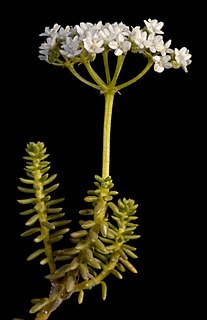
Platysace deflexa, known by its Noongar name Youlk or as Ravensthorphe radish, is a small shrub endemic to the south west of Western Australia.
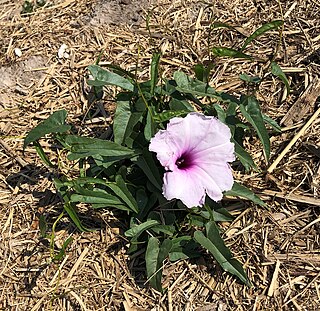
Ipomoea calobra, commonly known as weir vine, is an Australian native plant found in northern Australia, largely Western Australia and Queensland.
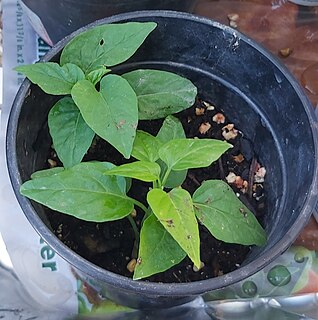
Ipomea macrorhiza is an extremely rare species of tuberous, night-blooming morning glory native to the Southeastern United States.
